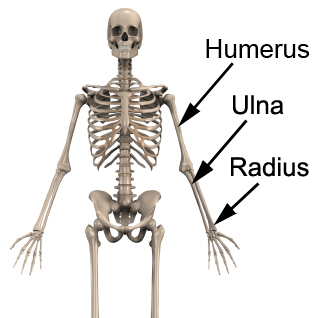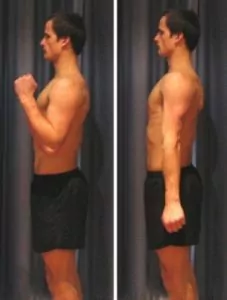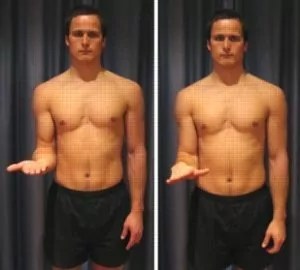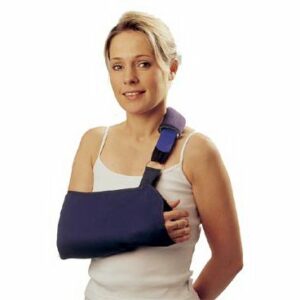Radial Head Fracture
Updated:
What is a radial head fracture?
A radial head fracture is a condition characterized by a break in the head of one of the long bones of the forearm known as the radius (figure 1). The head of the radius is located just below the outer aspect of the elbow joint (figure 2).


The forearm comprises of two long bones known as the radius and the ulna which are situated beside each other (figure 1). The radius bone lies on the thumb side of the forearm and forms joints with the upper arm bone (humerus) at the elbow, the ulna bone (both near the elbow and also, near the wrist) and several small bones at the wrist (figure 1). The radial head (or head of the radius) is a bony prominence at the top of the radius that forms a joint with the humerus and ulna and is situated just beneath the elbow joint on the outer aspect (figure 2).
During certain activities, such as a fall onto the outstretched hand or outer elbow, stress is placed on the radius bone and the radial head. When this stress is traumatic and beyond what the bone can withstand a break in the radial head may occur. This condition is known as a radial head fracture.
A radial head fracture is one of the most common fractures around the elbow in athletes. They can, however, occur in patients of all ages and fitness levels. Often a fracture to the radial head occurs in combination with other injuries, such as a sprain or dislocation of the wrist, elbow or shoulder, or fractures to other bones, such as the ulna, humerus or scaphoid.
Causes of a radial head fracture
A radial head fracture commonly occurs due to a traumatic weight bearing force, such as a fall onto an outstretched hand or outer elbow. This may occur with any fall, but is particularly common in sports such as skateboarding or snowboarding (particularly in icy conditions where a fall onto a hard surface is unforgiving). A fractured radial head may also occur due to a collision to the outer elbow with a fast moving or stationary object (particularly if the forearm or hand is fixed).
Signs and symptoms of a radial head fracture
Patients with this condition typically experience a sudden onset of sharp, intense elbow or forearm pain at the time of injury. This often causes the patient to cradle the affected arm so as to protect the injury. Pain is usually felt on the front, back or outer aspect of the elbow and forearm and can occasionally settle quickly leaving patients with an ache at the site of injury that is particularly prominent at night or first thing in the morning.
Patients with a radial head fracture may also experience swelling, bruising and pain on firmly touching the affected region of bone. Pain may also increase during certain movements of the elbow or wrist, when rotating the forearm, lifting or carrying or during weight-bearing activity (such as pushing) through the affected arm. Occasionally pins and needles or numbness may be present. In severe radial head fractures (with bony displacement), an obvious deformity may be detected.
Diagnosis of a radial head fracture
A thorough subjective and objective examination from a physiotherapist or doctor is essential to assist with diagnosis of a radial head fracture. An X-ray is usually required to confirm diagnosis. Further investigations such as an MRI, CT scan or bone scan may be required, in some cases, to assist with diagnosis and assess the severity of injury.
Treatment for a radial head fracture

Members Only ContentBecome a PhysioAdvisor Member to gain full access to this exclusive content. For more details see Become a Member. Already a member? Login Now
Prognosis of a radial head fracture
Patients with a radial head fracture usually make a full recovery with appropriate management (whether surgical or conservative). Return to activity or sport can usually take place in weeks to months and should be guided by the treating physiotherapist and specialist. In patients with severe injuries, involving damage to other bones, soft tissue, nerves or blood vessels, recovery time may be significantly prolonged.
Physiotherapy for a radial head fracture

Members Only ContentBecome a PhysioAdvisor Member to gain full access to this exclusive content. For more details see Become a Member. Already a member? Login Now
Other intervention for a radial head fracture

Members Only ContentBecome a PhysioAdvisor Member to gain full access to this exclusive content. For more details see Become a Member. Already a member? Login Now
Exercises for a radial head fracture
The following exercises are commonly prescribed to patients with a fractured radial head following confirmation that the fracture has healed, and the orthopaedic surgeon has indicated it is safe to begin pain free mobilization. You should discuss the suitability of these exercises with your physiotherapist prior to beginning them. Generally, they should be performed 3 times daily and only provided they do not cause or increase symptoms.
Your physiotherapist can advise when it is appropriate to begin the initial exercises and eventually progress to the intermediate and advanced exercises. As a general rule, addition of exercises or progression to more advanced exercises should take place provided there is no increase in symptoms.
Initial Exercises
Elbow Bend to Straighten
Bend and straighten your elbow as far as you can go without pain and provided you feel no more than a mild to moderate stretch (figure 3). Repeat 10 times provided there is no increase in symptoms.

Forearm Rotations
Begin this exercise with your elbow at your side and bent to 90 degrees (figure 4). Slowly rotate your palm up and down as far as you can go without pain and provided you feel no more than a mild to moderate stretch. Repeat 10 times provided there is no increase in symptoms.

Intermediate Exercises

Members Only ContentBecome a PhysioAdvisor Member to gain full access to this exclusive content. For more details see Become a Member. Already a member? Login Now
Advanced Exercises

Members Only ContentBecome a PhysioAdvisor Member to gain full access to this exclusive content. For more details see Become a Member. Already a member? Login Now
Rehabilitation Protocol for a Radial Head Fracture

Members Only ContentBecome a PhysioAdvisor Member to gain full access to this exclusive content. For more details see Become a Member. Already a member? Login Now
 Physiotherapy products for a radial head fracture
Physiotherapy products for a radial head fracture
Some of the most commonly recommended products by physiotherapists to hasten healing and speed recovery in patients with this condition include:
To purchase physiotherapy products for a fractured radial head, visit the PhysioAdvisor Shop.
 Find a Physio
Find a Physio
Find a Physiotherapist in your local area who can treat this condition.
 More Exercises
More Exercises
 More information
More information
- View detailed information on when to use Ice or Heat.
- Learn about initial injury management and the R.I.C.E. Regime.
- View comprehensive physiotherapy information on Elbow Taping.
- Explore why your injury may not be improving.
- Read our Elbow Diagnosis Guide.
Become a PhysioAdvisor Member
-
 Individual Membership (12 Months)$59.95 for 1 year
Individual Membership (12 Months)$59.95 for 1 year -
 Individual Membership (3 Months)$39.95 for 3 months
Individual Membership (3 Months)$39.95 for 3 months -
 Individual Membership (Yearly)$49.95 / year
Individual Membership (Yearly)$49.95 / year -
 Individual Membership (Monthly)$15.95 / month
Individual Membership (Monthly)$15.95 / month

Link to this Page
If you would like to link to this article on your website, simply copy the code below and add it to your page:
<a href="https://physioadvisor.com.au/injuries/elbow-forearm/radial-head-fracture”>Radial Head Fracture – PhysioAdvisor.com</a><br/>PhysioAdvisor offers detailed physiotherapy information on a radial head fracture including: causes, symptoms, diagnosis, treatment, exercises, physiotherapy products and more...
Return to the top of Radial Head Fracture.







